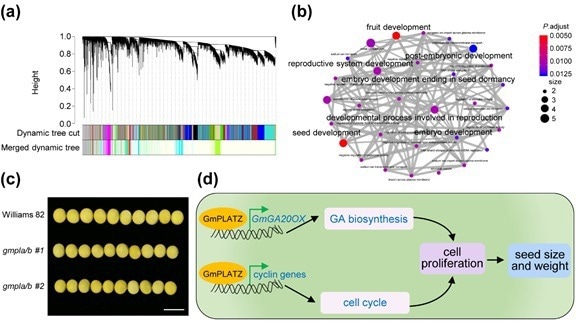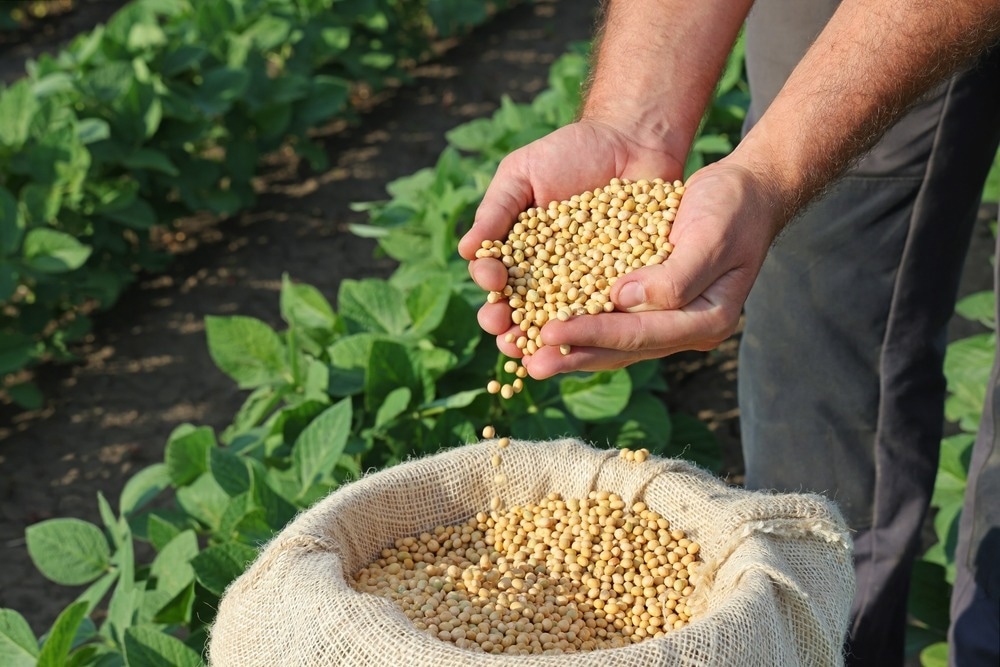Reviewed by Danielle Ellis, B.Sc.Oct 31 2023
The soybean (Glycine max) stands as a significant economic crop, offering valuable resources such as edible oil, plant-based protein, and various essential nutrients for human consumption. It had its origins and was first domesticated in China.
 Gene identification, phenotype analyses and working model of GmPLATZ. (a) Hierarchical clustering tree based on co-expression network; (b) The GO enrichment for constantly accumulated genes; (c) Seeds from Williams 82 and gmpla/b mutant plants; (d) Working model of GmPLATZ in controlling seed size and weight. Image Credit: IGDB.
Gene identification, phenotype analyses and working model of GmPLATZ. (a) Hierarchical clustering tree based on co-expression network; (b) The GO enrichment for constantly accumulated genes; (c) Seeds from Williams 82 and gmpla/b mutant plants; (d) Working model of GmPLATZ in controlling seed size and weight. Image Credit: IGDB.
The discovery of new seed control mechanisms from the wealth of available soybean accessions in China holds substantial significance in terms of unraveling associated regulatory systems and advancing the development of modern cultivars through breeding programs.
Under the guidance of Professor Jinsong Zhang at the Institute of Genetics and Developmental Biology (IGDB) within the Chinese Academy of Sciences, a team of researchers has pinpointed the regulatory factor GmPLATZ within seed transcriptomes.
Furthermore, they have established that GmPLATZ governs seed weight and size by acting through the GmPLATZ-GmGA20OX/cyclins module in soybean.
Their study was reported in the journal New Phytologist on October 15, 2023.
By employing RNA sequencing and conducting co-expression network analysis of forty-five different soybean accessions, the research team successfully pinpointed one hundred and ninety-nine regulators responsible for seed weight.
In a complementary analysis, the transcriptomes of seven distinct developmental stages of soybean seeds were meticulously examined, revealing a total of 173 genes closely tied to the developmental process.

Image Credit: branislavpudar/Shutterstock.com
From the two gene sets, the researchers pinpointed GmPLATZ and established its crucial role in enhancing seed weight and size in soybean.
GmPLATZ achieved this by triggering the expression of six cyclin genes and GmGA20OX through binding to their respective promoters. A critical palindromic element, AATGCGCATT, proved essential for GmPLATZ binding. Introducing GmGA20OX in excess resulted in a significant increase in both soybean seed size and weight.
Notably, PLATZ was singled out during the domestication of soybean, and its counterparts in Arabidopsis and rice also exhibited an influence on seed size and weight.
These findings offer valuable insights into effective strategies and promising gene targets for molecular breeding in soybean.
Source:
Journal reference:
Hu, Y., et al. (2023) Global analysis of seed transcriptomes reveals a novel PLATZ regulator for seed size and weight control in soybean. New Phytologist. doi.org/10.1111/nph.19316.